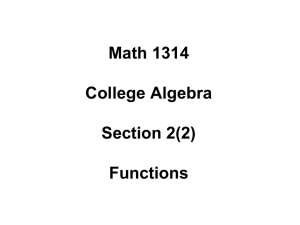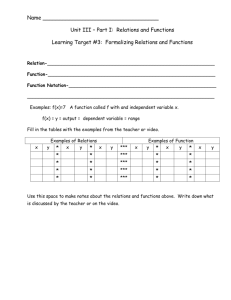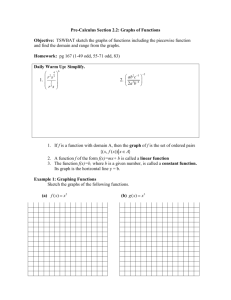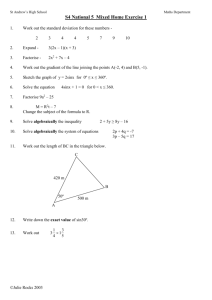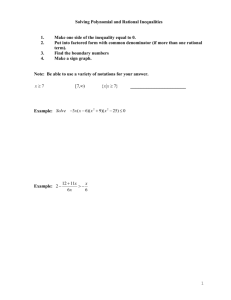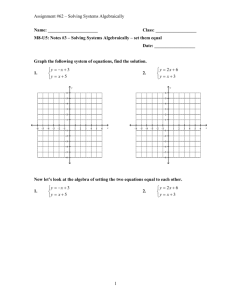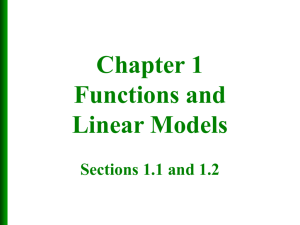Absolute Value Notes
advertisement
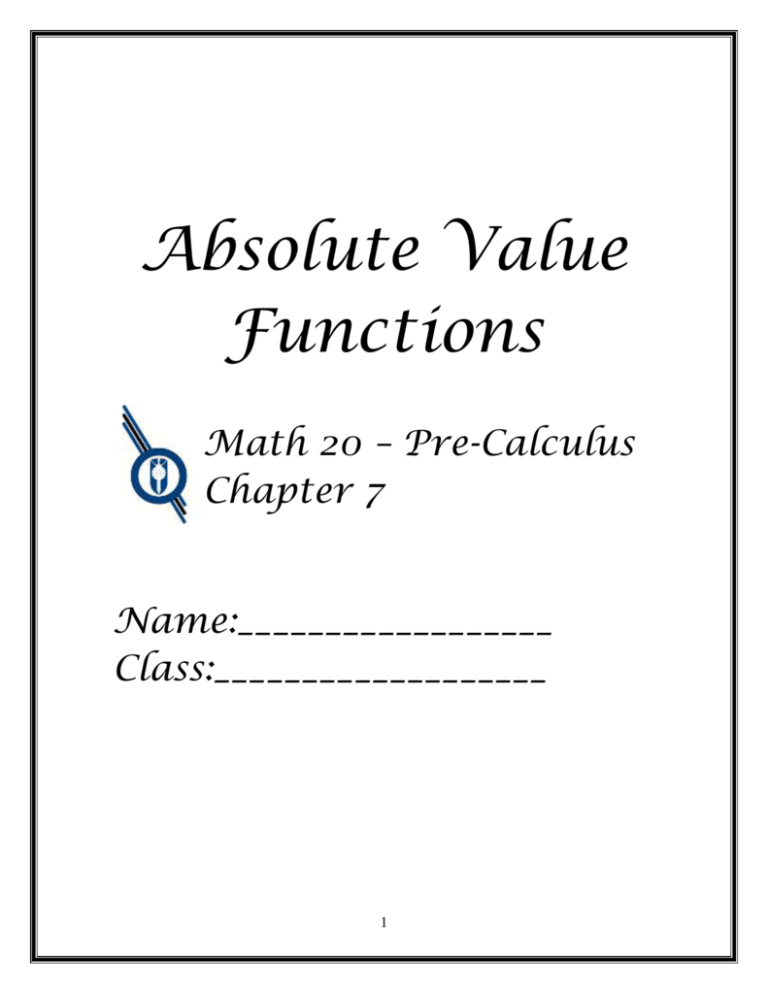
Absolute Value Functions Math 20 – Pre-Calculus Chapter 7 Name:__________________ Class:___________________ 1 Algebra and Number Specific Outcomes Demonstrate an understanding of the absolute value of real numbers. General Outcome: Develop algebraic reasoning and number sense. Achievement Indicators: The following set of indicators may be used to determine whether students have met the corresponding specific outcome 1.1 1.2 1.3 1.4 1.5 Relations and Functions Specific Outcomes Graph and analyze absolute value functions (limited to linear and quadratic functions) to solve problems. Determine the distance of two real numbers of the form ±a,a∈ R , from 0 on a number line, and relate this to the absolute value of a ( a ). Determine the absolute value of a positive or negative real number. Explain, using examples, how distance between two points on a number line can be expressed in terms of absolute value. Determine the absolute value of a numerical expression. Compare and order the absolute values of real numbers in a given set. General Outcome: Develop algebraic and graphical reasoning through the study of relations. Achievement Indicators: The following set of indicators may be used to determine whether students have met the corresponding specific outcome 2.1 Create a table of values for y f x , given a table of values for y f x . 2.2 Generalize a rule for writing absolute value functions in piecewise notation. 2.3 Sketch the graph of 2.4 2.5 y f x ; state the intercepts, domain and range; and explain the strategy used. Solve an absolute value equation graphically, with or without technology. Solve, algebraically, an equation with a single absolute value, and verify the solution. f x 0 has no solution. 2.6 Explain why the absolute value equation 2.7 Determine and correct errors in a solution to an absolute value equation. Solve a problem that involves an absolute value function. 2.8 2 7.1 Absolute Value On the number line, the numbers 4 and –4 are each located 4 units from 0 Each number is said to have an absolute value of 4. We write: 4 4 and 4 4 The absolute value of any real number is . . . The absolute value of any number other than 0 is positive. The absolute value of 0 is 0. When using order of operations absolute value bars mean the same thing as brackets. Everything inside the absolute value bars must be calculated first, then the expression is written without the absolute value bar and then any other operations are done in proper order. You cannot use the distributive property with absolute value. Problem #1 Write each expression without the absolute value symbol. (a) 29 (d) 15 1 2 (b) 12 (c) 51 17 (e) 6.7 (f) 1.8 3 Problem #2 Order each set of numbers from least to greatest. 1 1 2 6 , , , , 5 5 5 5 4 5 Example #2 Order each set of numbers from least to greatest. 1 , 7 7 , 7 1 9 , , 7 7 4 7 Problem #3 Evaluate the following expressions. (a) 3 7 (b) 5 11 (d) 2 5 (e) 14 9 (g) 3 2 3 3 (c) 9 7 2 2 (f) (h) 2 6 4 2 1 10 36 5 4 Example #3 Evaluate each of the following expressions. (a) 5 1 7 (b) 4 5 8 (d) 5 2 3 4 (e) 3 1 2 6 2 (c) 9 1 3 (f) 7 1 2 5 14 15 Problem #4 Write an expression to determine the distance between the following points on the number line. A to B B to A A to C C to A B to C C to B Textbook Page 363 #1-6 5 7.2 Absolute Value Functions Part I: Graphing Definition: An absolute value function can be defined as any function of the form y a b x c d , where a, b, c and d are any real number values and a 0 . A simple example of an absolute value function is y x . Problem #1 Given the following table of values for the function y f x , create a table of values for y f x x f x –3 –2 –1 0 1 2 3 4 6 4 2 0 -2 -4 -6 -8 f x Problem #2 Use the graph of y f x to sketch the graph of y f x y f x 6 Use the graph of y g x to sketch the graph of y g x y g x Use the graph of y h x to sketch the graph of y h x y h x 7 A sketch and table of values for the function y x are shown below. y x x –3 –2 –1 0 1 2 2.5 3 The domain of the function y x is The range of the function y x is The zero of the function y x is The y-intercept of the function y x is 8 y x Problem #3 Some transformed absolute value functions are shown below. State the domain, range, zero (x-intercept) and y-intercept for each function. y x3 x Dom _______ Ran _______ Zero _______ y-int _______ y x3 –6 –5 –4 –3 –2 –1 0 1 y x 2 x Dom _______ Ran _______ Zero _______ y-int _______ y x 2 –3 –2 –1 0 1 2 3 4 y x x –3 –2 –1 0 1 2 3 4 Dom _______ Ran _______ Zero _______ y-int _______ 9 y x Problem #4 Sketch the graph of each function. State the domain, range and intercepts of each function. y x5 y 2x 4 y 1 x2 2 y x 4 2 x 5 10 y 2 x 1 5 2 y x 2 x 12 Textbook Page 375 #1-8 11 7.2 Absolute Value Functions Part II: Piecewise Functions and Invariant Points The absolute value function y x is defined as the piecewise function x , x 0 y x , x 0 Problem #5 Express each of the following functions as piecewise functions. y 3x 2 y 2x y 2 x4 3 y x 5x 4 2 y 2 x 1 8 2 12 Invariant Points An invariant point is . .. To determine the invariant point(s) of y f x and y f x … Problem #6 For each pair of functions, determine the interval of invariant point(s). y 2 x 4 and y 2 x 4 y 3x 9 and y 3x 9 y x 1 and y x 1 y x x and y x x 2 2 y x 4 2 2 9 and y x 4 9 2 Textbook Page 375 #9-14 13 2 7.3 Absolute Value Equations Definition: Any absolute value function y f x becomes an absolute value equation 0 f x when y is replaced with zero. An example of a absolute value function is y 2 x 3 7 . An example of a absolute value equation is 0 2 x 3 7 . Definition: The solutions (or roots) of an absolute value equation represent the zeros (or x-intercepts) of its corresponding absolute value function. *Keep the following points in mind before attempting to solve an absolute value equation* For a 0 , if x a , then x a . For example: If x 4 , then x 4 . A graphical analysis of the equation x 4 illustrates why two solutions exist. The graphs of the functions y x and y 4 are shown below. The solutions to the equation x 4 can be found where the two functions intersect. 14 Example 1: Solve the equation x3 5 graphically. x –4 –2 0 2 3 4 6 8 10 Solve the equation x3 5 algebraically. Step 1: Apply the principle: If x a , then x a . Step 2: Solve both equations. Step 3: Verify each solution using the original equation. 15 y x3 y 5 Extraneous Roots/Solutions . .. Example #2: Solve the equation x 3 x 5 0 algebraically. Solution: Step 1: Isolate the term containing the absolute value sign. Step 2: Apply the principle: If x a , then x a . Step 3: Solve both equations. Step 4: Check the solution by substituting into the original equation. 16 Example #4: Solve the equation x 2 4 x 5 2 algebraically. Example #5: Solve the equation x 11 x 2 11x algebraically. 17 Example #6: Solve the equation 2 x 2 7 x 1 3 algebraically. Example #7 A car is travelling toward the Saskatchewan Alberta border. The car is 150 km from the border and is travelling at an average speed of 100 km/h. a) Write an absolute value equation to represent the distance (d ) of the car from the border after t hours (recall . .. d = rt ) b) Determine when the car is 25 km from the border. Textbook Page 389 #2, 4-7, 15 18


